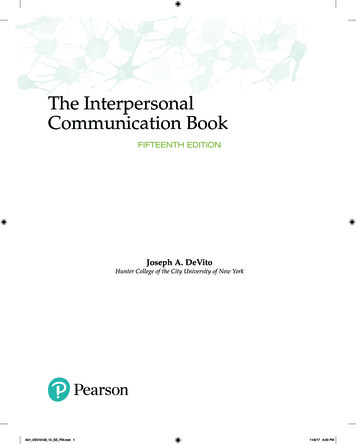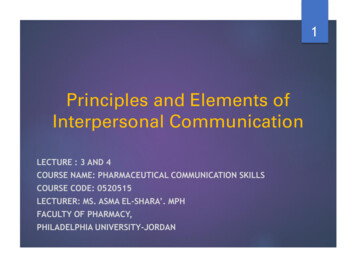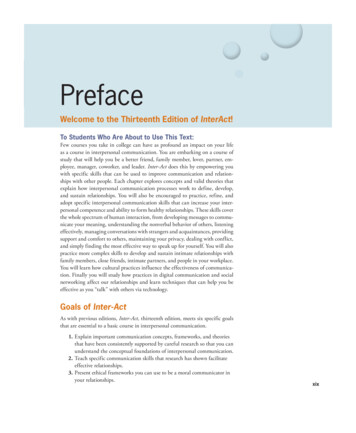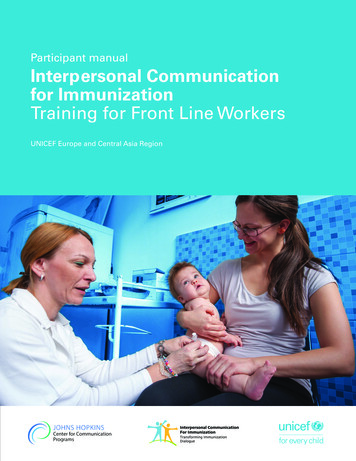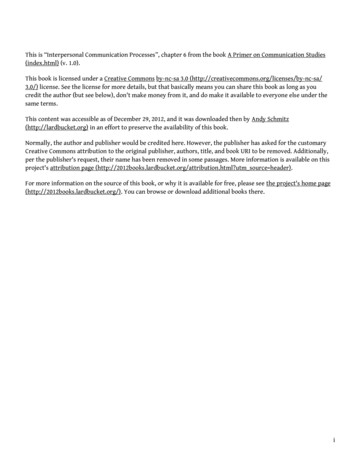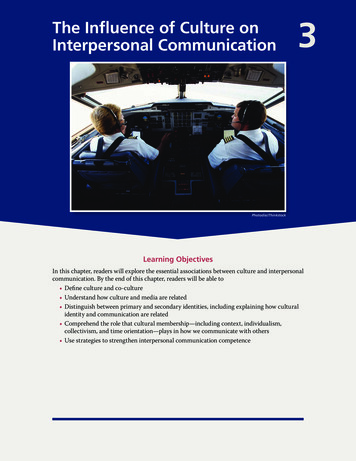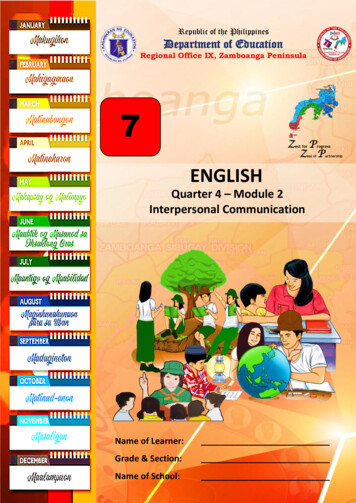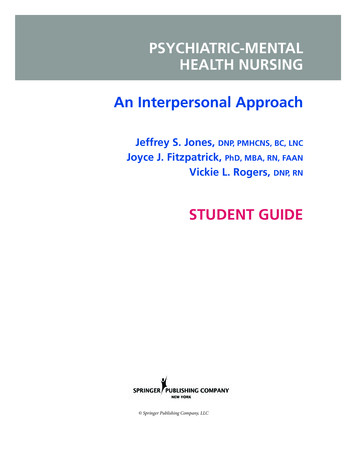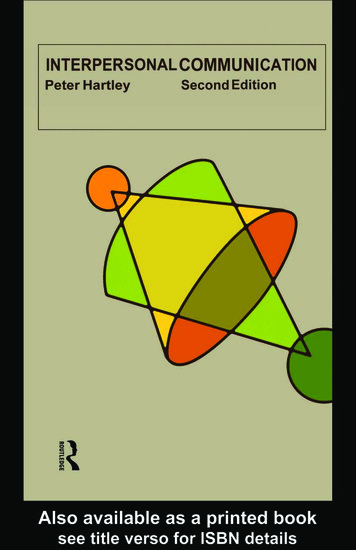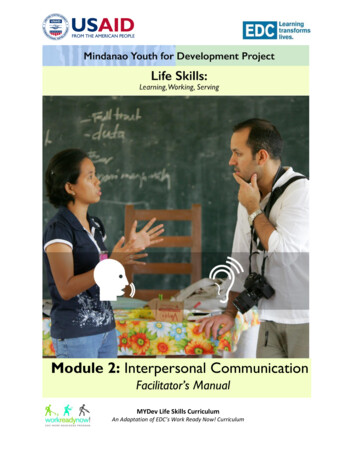
Transcription
Module 2: Interpersonal CommunicationFacilitator’s ManualMYDev Life Skills CurriculumAn Adaptation of EDC’s Work Ready Now! Curriculum
Module 2: Interpersonal CommunicationFacilitator’s ManualModule 2: Interpersonal Communication“Sa komunikasyon mahalaga ang unang impresyon”The first impression you give is important in communication.Interpersonal Communication ObjectivesBy the end of the module, participants will: Identify and demonstrate non‐verbal communication Listen actively and speak appropriately Identify and practice good customer service skillsModule Overview Activity Time Session 1: Listening & Speaking Effectively1: Introductory Activity & Learner’s Reflection2: Non-Verbal Communication3: Effective Listening4: Effective Speaking5: Choosing a form of communication Session 2: Cooperating with Others6: Self-Assessment of Working in Groups7: Cooperating with Others Session 3: Customer Care8: Giving Exceptional Customer Service9: Customer Service and the Role of Word ofMouth10: Module 2 Review and Application4 hr 20 min1 hr35 min45 min1 hr1 hr1 hr 45 min35 min1 hr 10 min3 hrs 5 min1 hr 10 min45 min1 hr 10 minTotal Time: 9 hr 10 minMindanao Youth for Development Project Life Skills Curriculum, adapted from EDC’s WRN! Curriculum 2016 Education Development Center, Inc. All Rights Reserved.Page 2
Module 2: Interpersonal CommunicationFacilitator’s ManualModule 2 Materials and Preparations Basic training materials: manila paper, markers, tape, A4 paper Make sure participants have their Participant’s Handbook available.Session 1: Before the activity, ask for 2 volunteers to prepare a brief role play for Step 3 (below)Prepare a visual with the phrase in Step 3 (below)1 paper ball (or another object that can be tossed from person to person)Review main concepts from previous modulePrepare a manila paper with the proverb (below) to discuss with learners.Learners’ ReflectionReview objectives of the moduleIdentify how non-verbal communication plays a role in the next topics: listening andspeaking skillsMake 3 copies of Facilitator Tool 2.A: Listening Scenarios and select an appropriate roleplay to use with the participants or create a new oneBefore the activity, ask for volunteers to prepare the role play, give them a copy of the roleplay and brief them on what they will need to doHandout 2.1: Effective Listening Observation FormMake 3 copies of Facilitator Tool 2.B and select an appropriate role play to use with theparticipants or create a new oneBefore the activity, ask for volunteers for the role play. Give them a copy of the descriptionof the role play and brief them on what they will need to doHandout 2.2: Effective Speaking Skills & StrategiesHandout 2.3: Three Forms of Workplace Communication.Session 2: Handout 2.4: Working in Groups Self-Assessment Handout 2.5: Cooperating with Others Roles Make copies and cut-out the roles for all participants from Trainer Tool 2.C: Roles forActors and Observers Handout 2.6: Elements of an Effective & Cooperative Team MemberSession 3: Before the activity, ask for volunteers to prepare to perform the scenario in Facilitator Tool2.D: Role Play on Customer Service. Make copies of this Trainer Tool as needed. Handout 2.7: Giving Exceptional Customer Service Write down the phrase (Step 1 below) on manila paper. Paper strips with the statements: strength, weakness, learning, challenge Paperballs, box Fast music (mp3, cellphone) Make 1 copy per participant of the End-of-Module AssessmentMindanao Youth for Development Project Life Skills Curriculum, adapted from EDC’s WRN! Curriculum 2016 Education Development Center, Inc. All Rights Reserved.Page 3
Module 2: Interpersonal CommunicationFacilitator’s ManualSESSION 1: LISTENING AND SPEAKING EFFECTIVELY Activity 1: Introductory Activity Objectives -By the end of the activity, participants will be able to:a. Review the main concepts of the previous module (Personal Development)b. Identify the topics that are important for interpersonal communicationsc. Take a Learner’s Reflection Time Required: 60 minutes Methodology: pair share, large group discussion Materials and Preparation: manila paper, A4 paper, markers, tape Before the activity, ask for 2 volunteers to prepare a brief role play for Step 3 (below)Prepare a visual with the phrase in Step 3 (below)1 paper ball (or another object that can be tossed from person to person)Review main concepts from previous modulePrepare a manila paper with the proverb (below) to discuss with learners.Learners’ ReflectionReview objectives of the moduleSteps: Facilitator Tip 1. Welcome learners to Module 2 and quicklyreview the main concepts from the previousYou can use othermodule by having participants throw a ball ortechniques such as havingother object to one another. The person whoa quiz bee or contestcatches the paper ball, has to mention a conceptamong groups toencourage learners toor idea from the previous module.participate(Types of important values and skills, how to setand reach goals, and different ways people learn.)Continue until the main concepts are covered, providing input as needed.(10 min)2. Ask participants to think about the proverb found at the beginning of Module 2: “Sakomunikasyon mahalaga ang unang impresyon” (The first impression you give isimportant in communication). In your own words, how do you relate this proverb toyourself? Can you recall your first impression situation with someone else? Do youthink the way you talk with your listener is important? (Facilitator calls someone whocan start the sharing).Explain that this module will focus on communication skills at work. Ask them whatthey think is the relevance between the proverb and the importance ofMindanao Youth for Development Project Life Skills Curriculum, adapted from EDC’s WRN! Curriculum 2016 Education Development Center, Inc. All Rights Reserved.Page 4
Module 2: Interpersonal CommunicationFacilitator’s Manualcommunication skills at work. How does it relate to their real life situation? The firstsession will cover speaking and listening.(10 min)3. Show the picture below or a visual with this line “I hear you, but I’m not listening”written in a manila paper and ask 2 volunteers (pre-briefed) to act out a shortscenario on this as everyone observes. Then let them identify the characteristics ofeach actor. Ask them, what do you observe about the 2 characters? Do you think themessage speaks about a rude person? Is being rude a good attitude?Form 4 small groups by counting 1-4 (group them according to their number). Eachgroup chooses a facilitator, a secretary to write down the ideas in the manila paper anda reporter to present the output. Each group discusses briefly and shares theirthoughts on the following questions and write theiranswers on manila paper:1. What does it mean to listen/speak effectively?2. How do you know when you are/are not beinglistened to or ignored?3. What do you do when speaking to get your pointacross?4. How do you speak to an elder? Supervisor? Friend?Group of people?5. Why is good (or effective) communication importantin our personal and work lives?(20 min)4. Each assigned reporter in each group is given 2 minutes to present the group output.After all presentations, the facilitator will explain that in this session they are going tolearn about communication skills and how to become more effective and confidentlisteners and speakers.(5 min)Have learners take the Learner’s Reflection in their Participnat’s Handbook. Explainthat this is not a test but is a way to see what they already know or do not knowabout the topics.Explain the meaning of each column (1, 2, 3, 4). Tell them that you will read a fewstatements. For each statement they need to check the column that best describesthem. Stress the importance of answering honestly and independently.Read one statement at a time and allow time for learners to think of an answer.(15 min)Mindanao Youth for Development Project Life Skills Curriculum, adapted from EDC’s WRN! Curriculum 2016 Education Development Center, Inc. All Rights Reserved.Page 5
Module 2: Interpersonal CommunicationFacilitator’s Manual Key Topics Non-verbal communicationEffective speaking skills & strategiesEffective listenin skills & strategiesMindanao Youth for Development Project Life Skills Curriculum, adapted from EDC’s WRN! Curriculum 2016 Education Development Center, Inc. All Rights Reserved.Page 6
Module 2: Interpersonal CommunicationFacilitator’s ManualLearners’ Reflection: Module 2 Interpersonal CommunicationThis is not a test but is a way for us to see what you already know or do not know about the topics. I will read askill that is listed in the left column. Think about yourself and your experience. I will read the statements acrossthe top. Check the column that best represents your situation. The results will guide me in helping you learnmore about this topic.Ang mga katanungan dito ay hindi test. Ito ay isang paraan upang malaman natin ang inyong kaalaman, kasanayano kakayahan tungkol sa paksang ito. Lahat ng inyong mga kasagutan ay ating tatanggapin.Babasahin ko ang bawat tanong. Magbalik‐tanaw sa inyong mga karanasan at i‐tsek ang sagot na naaangkop sainyong sitwasyon. Ang inyong kasagutan ay magiging gabay ko sa pagpapalawak ng inyong kaalaman tungkol sapaksang ito.My experienceKnowledge, skills and abilitiesKaalaman, kasanayan at kakayahan1I don’t haveanyexperiencedoing this.2I have verylittleexperiencedoing thisWala akongkaranasan sapaggawanitoKauntingkauntilamang angkaranasan kosa paggawanito3I have someexperiencedoing this.Mayroonakongkaranasan sapaggawanito4I have a lotofexperiencedoing this.Maramiakongkaranasan sapaggawanitoUsing a variety of strategies to listen carefullyto others / Paggamit ng iba’t-ibang istratehiyapara makinig nang mabuti sa iba.Usingandunderstandingnon-verbalcommunication cues / Paggamit at pag-unawang mga kilos na nagpapahiwatig ng pakikipagusap.Asking questions of others when I do notunderstand / Paghingi ng tulong sa iba kungmerong hindi naintindihan.Speaking clearly and effectively in front ofindividuals or groups /Pagsalita nangmaliwanag at mabisa sa harapan ng mga tao ogrupo.Understanding the importance of customercare and service / Pag-intindi sa kahalagahanng pag- alaga ng kustomer at pagbibigay ngkaukulang serbisyo.Striving to provide exceptional customerservice, in person or on the telephone /Pagsikap upang makabigay ngpinakamagandang serbisyo sa telepono oharapang pakikitungo sa taoMindanao Youth for Development Project Life Skills Curriculum, adapted from EDC’s WRN! Curriculum 2016 Education Development Center, Inc. All Rights Reserved.Page 7
Module 2: Interpersonal CommunicationFacilitator’s Manual Activity 2: Non-Verbal Communication Objectives – By the end of the activity, participants will be able to:a. Identify and demonstrate examples of non-verbal communicationb. Be aware of how non-verbal communication impacts the way we give and receiveinformation Time Required: 35 minutes Methodology: pair work, large group discussion Materials and Preparation: Identify how non-verbal communication plays a role in the next topics: listeningand speaking skillsSteps:1. Divide participants into 2 groups by having them count 1, 2, 1, 2 Ask group 1 to form acircle. Ask group 2 to form a circle around group 1. Participants in the inner circleshould face those in the outer circle.(5 min)2. Tell participants to demonstrate to the person they are facing as many ways that theycan think of for communicating without using words.“Show ways that you can communicate how you feel, what you think, or what youwant – without talking.”(10 min)3. Before introducing the topic, you may ask participants what type of communicationwere they using when doing the activity. Explain that non-verbal communication is away to communicate using your body, including facial expressions, using hands or feet,and more. Some examples of non-verbal communication include nodding one’s head inagreement, rolling eyes in disagreement, looking at watch and tapping foot in boredom,smiling, etc. Explain that “the way we use our body can help or interfere ourcommunication with others. Our body can show if we are interested in what the otherperson is saying or distracted, can show respect or direspect to the other person, andcan give many more messages. We do not always need to talk in order to communicate.There are other ways to send messages.”Using the same group, give copies of a picture below and let them identify what eachfacial expression means.Mindanao Youth for Development Project Life Skills Curriculum, adapted from EDC’s WRN! Curriculum 2016 Education Development Center, Inc. All Rights Reserved.Page 8
Module 2: Interpersonal CommunicationFacilitator’s ManualSource: 268-passion-i-like-the-way-you-lookTo process – ask “Why do you think non-verbal communication is important when givinginformation or when listening to someone? Can you tell the importance of knowing andrecognizing non-verbal communication?(20 min)Mindanao Youth for Development Project Life Skills Curriculum, adapted from EDC’s WRN! Curriculum 2016 Education Development Center, Inc. All Rights Reserved.Page 9
Module 2: Interpersonal Communication Facilitator’s ManualActivity 3: Effective Listening Objectives -By the end of the activity, participants will be able to:a. Identify effective listening skills & strategies Time Required: 45 minutes Methodology: role play, pair work, large group discussion Materials and Preparation: manila paper, markers, tape Make 3 copies of Facilitator Tool 2.A: Listening Scenarios and select an appropriate roleplay to use with the participants or create a new one Before the activity, ask for volunteers to prepare the role play, give them a copy of the roleplay and brief them on what they will need to do Handout 2.1: Effective Listening Observation FormSteps:1. Explain to participants that they are going to observe a 3-minute role play of aworkplace situation. Ask pre-selected volunteers to role play any scenario fromFacilitator Tool 2.A: Listening Scenarios. Discuss the role play by asking: What is the role play all about? Can you identify any misunderstanding? Why did this situation happen? Has a similar situation happened to you? Have you experienced not listening tosomeone speaking? Have you experienced speaking and the other person wasnot listening to you? What happened? If you were one of the characters, what will you do to avoid such situation?(30 min)2. Discuss effective listening skills and strategies using Handout 2.1: EffectiveListening Observation Form in their Participant’s Handbook.Read one statement at a time. Allow learners to show their answers standing up (Yes)or sitting down (No). If many learners answer “no” (sit down), ask: “What could theperson have done differently?” Explain that feedback should be given in a positive andencouraging way, not in a way that is judgmental or discouraging. Clarify if there areany questions.(15 min)Mindanao Youth for Development Project Life Skills Curriculum, adapted from EDC’s WRN! Curriculum 2016 Education Development Center, Inc. All Rights Reserved.Page 10
Module 2: Interpersonal CommunicationFacilitator’s ManualFacilitatior Tool 2.A: Listening ScenariosRole Play 1: At the HotelOmar is a front desk worker at Lantaka Hotel. He is responsible for checking guests in, answeringthe phone, and responding to the needs of hotel guests. He and his girlfriend Sitti have beenhaving some misunderstanding lately so he has been distracted at work. An angry guest fromroom 202 comes to the desk to complain about dirty sheets. While the guest was complaining,Omar’s mobile phone rings. It was his girlfriend. He asks the guest to wait for a minute but heends up getting into a heated discussion with Sitti. The guest becomes annoyed and says she isgoing to go out and expects clean sheets by the time she returns in her hotel room. Omar nodshis head in agreement and says, “No problem, it will be taken care of”. He continues with hisphone conversation and he is quite upset when he gets off. Things start to get busy at the hotel-‐‐the hotel phone keeps ringing and a busload of guests arrives to check-in. The guest fromroom 202 returns, gets her key and within minutes she went down in the lobby shouting thather dirty sheets have not been replaced.Role Play 2: At the StoreA young man named Jose works in a store selling items such as toothpastes, candles, pens, salt,sugar, and bread. He finds his boss, Maria, annoying and he tends not to listen to her all thetime. One day, they had two types of bread to sell. Maria made it clear that the higher qualityloaves should go for 50 pesos and the other ones for 30 pesos. All morning many customerscame in to buy bread. Jose sold all loaves for the same price -‐‐ 30 pesos. When Maria returned,she realized that Jose sold the good quality bread for only 30 pesos. She got angry and said shewould make Jose pay the difference.Role Play 3: At the Construction SitePatrick is new in his job at Candace Construction. His job is to mix cement for a wall that they arebuilding. His supervisor had told him that for every bag of cement he should mix in 5 bags ofsand. Distracted by all the noise around him, he couldn’t remember the number of bags of sandto add to the cement. He feared he would lose his job if he asked the supervisor again, so he didwhat he thought was right – 10 bags of sand for every bag of cement. After the wall had been upa few days, the wall crumbled.Mindanao Youth for Development Project Life Skills Curriculum, adapted from EDC’s WRN! Curriculum 2016 Education Development Center, Inc. All Rights Reserved.Page 11
Module 2: Interpersonal CommunicationFacilitator’s Manual Handout 2.1: Effective Listening Observation FormStand up if your answer is yes (if the listener uses the standard) or sit down if your answer is no(if s/he does not use the standard).StandardsYesNoDo you use appropriate body language to show you are listening? (eyecontact, sit upright, nod head, etc.)Do you listen to the speaker without interrupting?Do you repeat what the speaker has said to make sure you haveunderstood correctly?Do you ask questions for clarification when you do not understandsomething?Do you avoid being distracted by noises, mobile phones, or by whatother people are doing?Do you avoid being distracted by the mannerisms, speaking style,clothing of the person speaking?Are you aware of your own attitude & do you avoid being judgmental?Mindanao Youth for Development Project Life Skills Curriculum, adapted from EDC’s WRN! Curriculum 2016 Education Development Center, Inc. All Rights Reserved.Page 12
Module 2: Interpersonal CommunicationFacilitator’s Manual Activity 4: Effective Speaking Objectives -By the end of the activity, participants will be able to:a. Identify effective speaking skills and strategies Time Required: 60 minutes Methodology: role play, pair work, large group discussion Materials and Preparation: manila paper, markers, tape Make 3 copies of Facilitator Tool 2.B and select an appropriate role play to usewith the participants or create a new one Before the activity, ask for volunteers for the role play. Give them a copy of thedescription of the role play and brief them on what they will need to do Handout 2.2: Effective Speaking Skills & StrategiesSteps:1. Facilitator introduces a message relay game. Learners form 3 teams with equal no. ofmembers. All members of the team line up in front of a desk with pencil and paper onit. The last person in the line is designated as the READER. The READER of every teamcomes in front to silently read a sentence that you have written in a metacard. Whenthe signal is given, the READERS go back to their respective lines and whispers thesentence starting with the person from the back, and so on until the message reachesthe person in front. The latter writes down the sentence. When the writer is finisheds/he runs to the teacher with the paper. The first team to get the sentence correctlywins. End the game by asking the class to read the sentence with correctpronunciation. Process the game by asking:- What lesson can we get from the activity?- What will happen if we don’t speak clearly?(15 min)2. Explain to the learners the importance of focusing on speaking. Discuss the importanceof being present, open and connected to those you are speaking to both in speech andbody language.Ask participants when do they think they will need to use effective speakingskills. (Presenting ideas at work either formally to a supervisor or group ofcolleagues or informally to co-‐‐workers; socially with family and friends.)(10 min)3. Explain to participants that they are going to observe a 3-minute role play of aworkplace situation. Select the role play you chose from Facilitator Tool 2.B and read itout loud. Then ask some volunteers (that you pre-selected and briefed ahead of time)Mindanao Youth for Development Project Life Skills Curriculum, adapted from EDC’s WRN! Curriculum 2016 Education Development Center, Inc. All Rights Reserved.Page 13
Module 2: Interpersonal CommunicationFacilitator’s Manualto act out the scenario.Discuss the role play by asking: Was the speaker able to give aclear message? What are some effective speakingstrategies that the speaker used? What are some things that thespeaker can use next time to be amore effective speaker? Facilitator Tip You may need to change thespeaking scenarios so they aremore relevant to the workcontext in which theparticipants are coming from.(15 min)4. In a large group review and discuss the effective speaking skills and strategies. Asklearners to go to Handout 2.2: Effective Speaking Skills & Strategies in theirHandbook.(10 min)5. Ask them to use the standards in Handout 2.2 to assess the listening skills theyobserved in the role play.Read one statement at a time, allow learners to show their answers clapping orstomping. If many learners answer “no” (stomp), ask: “What could the person havedone differently?” Explain that feedback should be given in a positive and encouragingway, not in a way that is judgmental or discouraging. Clarify if there are any questions.(10 min)Mindanao Youth for Development Project Life Skills Curriculum, adapted from EDC’s WRN! Curriculum 2016 Education Development Center, Inc. All Rights Reserved.Page 14
Module 2: Interpersonal CommunicationFacilitator’s ManualFacilitator Tool 2.B: Speaking ScenariosScenario 1: At the MallYou work as a cleaner at a mall with a team of 15 other cleaners. Recently, you have noticedthat the quality of the cleaning of some of your colleagues have not been very good and manyof them have not been showing up on time. The mall’s staff members have started complainingabout the unclean halls and stairways. Before these complaints get taken further to thecleaners’ manager, you decided to talk with your co-workers to encourage everyone to showup on time and do a better job next time.Scenario 2: At the Construction SiteYou have been hired by Royal Contractor. For the first few days, your supervisor has asked youto follow one of your co‐workers so you can be trained on the job. The co‐worker has anegative attitude and does not want to show you how to use all of the equipment properly.You know that if he shows you what to do, the two of you will be able to get the job donequickly and the boss will be pleased. You decide to talk to your co‐worker in a friendly and kindway that will convince him to train you properly.Scenario 3: At the RestaurantJericho is a young waiter at Cotabato Restaurant. One busy lunch time, an impatient customerwas told it would take over 30 minutes to prepare his Sinigang soup. The customer was angryand began insulting Jericho. Jericho tries his best to calm down the customer and he assureshim they’ll cook his order as fast as possible and serve it right away.Mindanao Youth for Development Project Life Skills Curriculum, adapted from EDC’s WRN! Curriculum 2016 Education Development Center, Inc. All Rights Reserved.Page 15
Module 2: Interpersonal CommunicationFacilitator’s Manual Handout 2.2: Effective Speaking Skills & Strategies Be clear, brief, concise – to the point Use examples to get to the point Be polite / friendly Be honest Be respectful When you need to be direct, speak with respect Speak with confidence but not with arrogance Be flexible – check the mood and attitudes of others and adjust accordingly Be aware of body language – your own and that of othersMindanao Youth for Development Project Life Skills Curriculum, adapted from EDC’s WRN! Curriculum 2016 Education Development Center, Inc. All Rights Reserved.Page 16
Module 2: Interpersonal CommunicationFacilitator’s Manual Activity 5: Choosing a Form of Communication Objectives - By the end of the activity, participants will be able to:a. Choose when to communicate verbally, electronically or in writing. Time Required: 1 hour Methodology: large group discussion, independent work Materials and Preparation: Handout 2.3: Three Forms of Workplace Communication.Steps:1. Explain that nowadays, there are many different ways of communicating. You maychoose to write an email, send an instant message, a text message, make a phone call, orwrite a formal letter. This activity will help you understand the different types ofcommunication used in the workplace so you can choose the right form depending onyour needs.(5 min)Ask for examples of each of the 3 main ways of communicating at work:1) Verbal2) Written3) Electronic2. Ask participants to go to Handout 2.3: Three Forms of Workplace Communication, Part 1in their Participant’s Handbook. Have them work in pairs to complete Part 1, decidingwhether each form of communication is verbal, written and/or electronic.(15 min)3. Review their responses in a large group. For each item,invite a participant to:a) Explain what it is.b) Give an example of when you may choose to useit in the workplace. Trainer Tip Go around the roomso everyone shares atleast once.(15 min)4. Review Part 2 of Handout 2.3 together as a group. Explain: Once you know what you aretrying to communicate, you need to select the best form of communication for yourmessage. The method you choose can make a big difference in how effectively youcommunicate your message.(10 min)Mindanao Youth for Development Project Life Skills Curriculum, adapted from EDC’s WRN! Curriculum 2016 Education Development Center, Inc. All Rights Reserved.Page 17
Module 2: Interpersonal CommunicationFacilitator’s Manual5. Have participants complete Part 3 of Handout 2.3. Review their responses as a largegroup.(15 min)Mindanao Youth for Development Project Life Skills Curriculum, adapted from EDC’s WRN! Curriculum 2016 Education Development Center, Inc. All Rights Reserved.Page 18
Module 2: Interpersonal CommunicationFacilitator’s Manual Handout 2.3: Three Forms of Workplace Communication1Part 1: Select the type(s) of communication for each format.FormatVerbalWrittenElectronicFace-to-face conversationPhone (landline)Mobile oReportProposalEmailFaxVoicemailWebinarConference CallVideo ConferenceProject Management WebsiteInstant Messaging (Skype)Email Mailing ListSMS / Text MessageSticky noteOther (please add):1Adapted from Ford Partnership for Advanced Studies, Media and Messages: Building a Foundation of CommunicationSkills, 2005.Mindanao Youth for Development Project Life Skills Curriculum, adapted from EDC’s WRN! Curriculum 2016 Education Development Center, Inc. All Rights Reserved.Page 19
Module 2: Interpersonal CommunicationFacilitator’s ManualPart 2: Choosing a Form of Workplace Communication2Choose a verbal message if Choose a written messageif You want immediateYou don’t need immediatefeedback.feedback.Your message is simple andYour message is complex andeasy to understand.requires planning.You don’t need a writtenYou need a written recordrecord of the interactionfor your filesYou can get together easilyYour audience is moreformalYou want to solve a problemor make a decisionYou want to avoidmiscommunicationChoose an electronicmessage if You need quick but notimmediate feedbackYour message is simple, butyou’re physically separatedYou need an electronicrecordYou are geographicallyspread out, or want to avoidtime-zone barriersYou want to avoidmiscommunication.Part 3: Choosing a FormInstructions: For each type of communication, there are 2 examples of how and when to use thatform of communication. Write 3 more examples for each form.VerbalYou call a co-worker to see ifthey can come help yousolve a problemYou introduce a new internto coworkers2WrittenYou write a letter invitingpeople to an eventElectronicYou use Skype to ask yourco-worker a quick questionYou prepare handouts for apresentationYou set up a webinar toshow the client the work youdid for themIbid.Mindanao Youth for Development Project Life Skills Curriculum, adapted from EDC’s WRN! Curriculum 2016 Education Development Center, Inc. All Rights Reserved.Page 20
Module 2: Interpersonal CommunicationFacilitator’s ManualSESSION 2: COOPERATING WITH OTHERS Activity 6: Self-Assessment of Working in Groups Objectives - By the end of the activity, participants will be able to:a. Assess how they tend to work in groupsb. Recognize that different personalities and approaches affect how a group performs itsroles and responsibilities Time Required: 35 minutes Methodology: self-assessment, large group discussion Materials and Preparation: manila paper, markers, tape, key Handout 2.4: Working in Groups Self-AssessmentSteps:1. Explain to participants that they are going to do a group activity called “Pass the KeyPlease”. Divide the group into 2 teams. Arrange the teams so they face one another.Members of each team th
Module 2: Interpersonal Communication “Sa komunikasyon mahalaga ang unang impresyon” The first impression you give is important in communication. Interpersonal Communication Objectives By the end of the module, participants will: Identify and demonstrate non‐verbal commu
